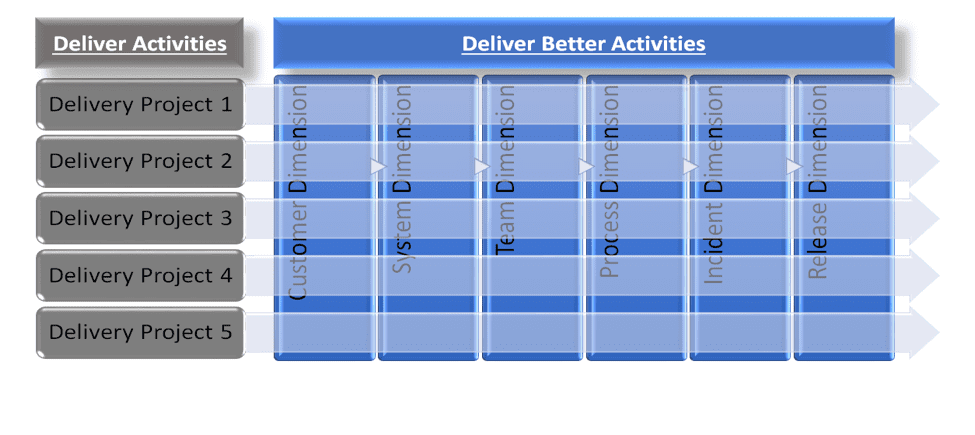Most departments in traditional businesses have a clear understanding of what better performance means. Sales is responsible for more sales, marketing is responsible for more impressions and improved brand identity, manufacturing is responsible for production quality and efficiency.
Information Technology has traditionally been measured on two key performance indicators, delivery pace and predictability, as well as cost of operations. Due to many reasons, it might be argued that the business (and IT) need a better framework for understanding the health and performance of the IT department.
The general sense is that things always seem to get slower and more expensive, and they absolutely will if IT and key stakeholders don’t understand and support the activities necessary to keep things fast and nimble. Too often, many of these activities are thrown into the “technical debt” or “technical cards” bucket.
Sometimes poor delivery predictability is due to the mechanics or execution of the delivery process (i.e. PMO/Project Management). But one could argue that most delivery problem root causes are far beyond the challenges that traditional project management could solve.
 If you think of the major factors or impediments to improved delivery pace and predictability, they tend to be on items like slow, manual release processes, frequent and significant production incident rates, late quality issues, poor understanding of business and customer problems and opportunities, poor system health, late cross-impacting and dependency problems.
If you think of the major factors or impediments to improved delivery pace and predictability, they tend to be on items like slow, manual release processes, frequent and significant production incident rates, late quality issues, poor understanding of business and customer problems and opportunities, poor system health, late cross-impacting and dependency problems.
None of these core areas of delivery issues are things that a traditional project delivery process is going to be able to effectively improve. They are core to the responsibilities of an effectively managed IT organization, yet are mostly left unaddressed organizationally unless the problem becomes so significant that an “internal” IT project is opened up to bandaid the issues back into place.
These core problems are more typically the real reasons behind the slowing down of delivery and higher costs. Likewise, all of these core problems almost always require a very broad set of stakeholders to understand, agree on, and drive improvement. Managers and individuals in the stakeholder groups almost always operate on many different and competing business projects at the same time.
Some of the organizational issues that can be observed in the absence of a good IT performance communication framework might be:
- Organize/Align – Teams struggle to organize activities and experiments without agreed upon measures of improved performance
- Wins and losses – experiments, prototypes and more importantly successes and failures tend to get lost in large organizations that don’t have a framework for communicating and celebrating improved performance
- Business support – Without a business-relevant performance communication framework, problems and opportunities all get lumped into the “technical debt” bucket
- Performance Reporting – Most organizations focus on project delivery as the key performance reporting (Deliver the book of work). Real improvements to delivery however have no real place to be communicated and supported without a business-relevant framework
If improving these core problems are the key to improved delivery, why are organizations not aligned and measured against these?
In order to really develop and demonstrate sustained improvements of delivery to the business and your customers, the organization needs to think and act across the organization much more effectively than they do today. Each manager and individual needs to think about their delivery responsibility along with their “deliver better” responsibility, and the appropriate organizational mechanisms need to be created to support those changes.
Every organization needs to create their own framework for communicating and managing performance, one that I have recently introduced is focused on six key dimensions of performance. Some objectives and outcomes clearly overlap across these dimensions, but in order to drive improved performance, the organization needs to settle on an effective communication and reporting framework for performance. You can combine these, remove some, add some, but the importance is on creating the framework and empowering all teams to work across the organization on solving problems within the framework.
An example of this communication framework might be something like:
- External to IT
- Customer Dimension – How effectively and efficiently do the systems solve the problems of the business/customer?
- Business Value Dimension – Can you solve the problem in such a way that the business won’t lose money doing so?
- Internal to IT
- System Dimension – How healthy are the current systems (old, costly, hard to maintain, brittle, etc.)?
- Team Health – How healthy are the teams (are they connected to the customer problems, are they engaged, do they act as though they are empowered)?
- Process/Quality – Do the teams/processes deliver quality products efficiently?
- Incident – Are teams constantly interrupted by production incidents?
- Release – Are releases manual, slow and prone to error?
All of these dimensions can and must be tied to the real business outcomes of speed, value and customer satisfaction. They all must have KPI’s and metrics that allow the entire innovation and change process to continually be optimized (e.g. DevOps). Without this, IT will continue to not meet business expectations and have difficulty getting support for keeping things fast, efficient and nimble. If there is no framework and expectation for improvement in IT, things will always go the other way, slow and costly, it is simply a product of the IT environment.
The figure below shows a view of how organizations might need to start thinking about managing an additional set of performance outcomes beyond basic delivery.
Many organizations have done a tremendous job of implementing certain aspects of lean and agile frameworks. However, it’s important to provide those team with a sense for what better performance really means.
Written by Jim Miller


